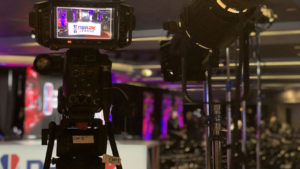While the idea of live streaming or broadcasting your conference, town hall, or the like has been a tool available to event producers for a long while – the fact of the matter is live streaming gained significant mindshare amid the pandemic.
Livestreaming, or broadcasting an event allows event producers to transform their experiences into hybrid events – in a manner pretty similar to sporting events – where there is both an in-person component and a remote audience. That means a new world of opportunities both for sponsors and the ability to reach global audiences.
Now, in light of the advancement of hybrid event productions, many event producers are jumping at opportunities to add live streaming to their events. However, despite the fact that these tools are available the fact of the matter is you need to think strategically with every event production to determine if using live streaming makes sense.
Will the schedule allow for a proper and foolproof live streaming setup?
It’s important as you think about adding a live streaming component to your event productions that you ensure you have the time to access to the space and setup the right production infrastructure for a quality live broadcast. Nothing is worse than a live broadcast that is glitchy, fails, or leaves a bad impression on your target audience. To accomplish that it’s important that you have the right space and time to set up, test and prepare for the live broadcast. So, if you are looking at an event and you would only have an hour or two to set up you might be better off capturing it and sharing it after the fact to ensure it is a quality video production.
Do Live Event Times Align With Target Audiences?
With access to global audiences, it’s important to be mindful of those audiences when producing live-streaming video content. So, if your event is at 6 PM in New York but it’s midnight where your target audience is – then you need to think if a live broadcast is the best approach both from a strategy and budgetary perspective. In some cases, audiences will be across a variety of time zones – so it does in fact make sense to go live – but at other times it may be beneficial to capture the content and post it or stream it on a time-shifted schedule to better accommodate the target audience time zone(s).
How are you approaching the live stream? Are you integrating comments and questions from the viewers with the IRL experience?
Again, thinking strategically about your hybrid event production and the live stream aspect there are a variety of ways to produce the broadcast. It depends on if you want to fully integrate the remote viewers and make them a part of the event, or if you want them to simply be able to observe the speakers and presentations. Naturally, it’s more immersive to have remote viewers be able to contribute and play a role in the hybrid event production, however doing so requires the right team and technological solution to connect all of the dots in a seamless fashion.
Have you thought about monetizing your live stream?
The fact of the matter is rather than viewing a hybrid event – or the associated live streaming component as a cost-factor it can be viewed as an opportunity for a new stream of revenue. Now, while there is a lot that goes into producing a quality hybrid event production – think team members, technology, and creative – there is also a world of possibilities to monetize your live stream and create exposure for sponsorship partners in a well-produced live stream that resonates with global viewers.
So, as you look to planning your 2023 events, and even getting a head start on 2024, it’s important to think holistically about your live event production and how you approach hybrid event production. Doing your homework in advance – thinking strategically about what type of production you want, how you want audiences to interact, and of course logistically about how to accommodate a live broadcast – will all go a long way to ensuring success and allow you to successfully execute any kind of hybrid event production.



